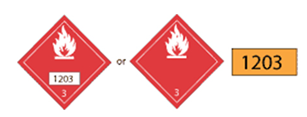Transportation of Dangerous Goods (TDG) - Dangerous Goods Marks or Dangerous Goods Safety Marks (Road)
On this page
- What are dangerous goods marks or dangerous goods safety marks?
- What is the purpose of dangerous goods marks or dangerous goods safety marks?
- When are dangerous goods marks or dangerous goods safety marks required?
- What are the general requirements for all dangerous goods marks or dangerous goods safety marks?
- Are safety marks that are not compliant with Part 4 of the TDG regulations acceptable, and when?
- Who has responsibilities for dangerous goods marks or dangerous goods safety marks?
- What are “misleading" dangerous goods marks or dangerous goods safety marks?
- What are the requirements for dangerous goods marks or dangerous goods safety marks when displayed on the means of containment
- What safety marks are required on a small means of containment (capacity 450L or less)?
- Are there other requirements for labels on a small means of containment?
- What safety marks are required on a large means of containment (capacity 450L or more)?
- How many placards are required on a large means of containment?
- Are safety marks required on overpacks?
- Are safety marks required on consolidation bins?
- Are there any exemptions for placards? And how does one select a placard for different loads?
- What types of "other" safety marks may be required?
What are dangerous goods marks or dangerous goods safety marks?
Back to topDangerous goods marks or dangerous goods safety marks are the first line of communication about the hazard(s) of the dangerous good. This communication is accomplished by the:
- colour used for the dangerous goods mark or dangerous goods safety marks (e.g., orange, red, blue),
- symbol (e.g., explosion, flames, corrosion, etc.),
- code or number for a particular hazard (e.g., 1- Explosive, 2 - Gases, 3 - Flammables)
- words (e.g., inhalation hazard, etc.)
These dangerous goods marks or dangerous goods safety marks can be:
- labels
- placards
- other marks such as:
- identification numbers
- shipping names
- orange panel
- sign
- handling marks
- letters, words, etc.
Note that the difference between labels and placards is their size. A label is used for a small “means of containment” whose capacity is 450 L or less. A placard is used for a large “means of containment” whose capacity is more than 450 L.
The dangerous goods marks or dangerous goods safety marks for each TDG class are shown in the OSH Answers document Transportation of Dangerous Goods (TDG) - 9 Classes. Other dangerous goods marks or dangerous goods safety marks are shown in Table 2 in this document (below).
Note 1 – The TDG Regulations were amended on July 5/2023. The definition of “dangerous goods safety mark” was withdrawn from the TDG Regulations. However, the TDG regulations and many Transport Canada publications still refer to the former terminology of “dangerous goods safety marks.” Thus, we include both terms in our OSH Answer Fact Sheet. The current TDG Act legal terms and definitions are as follows:
- Safety mark - means a dangerous goods mark or a compliance mark.
- Dangerous goods mark - means a symbol, device, sign, label, placard, letter, word, number or abbreviation, or any combination of those things, that is to be displayed to indicate the presence or nature of danger on dangerous goods, or on a means of containment or means of transport used in importing, offering for transport, handling or transporting dangerous goods.
Note 2: The information below is provided as guidance only. Always check with Transport Canada and the TDG Act and Regulations to ensure compliance.
Please also see the following documents in this series for road transportation of dangerous goods:
- Transportation of Dangerous Goods (TDG) – Overview (Road)
- Transportation of Dangerous Goods (TDG) - Training (Road)
- Transportation of Dangerous Goods (TDG) - 9 Classes
- Transportation of Dangerous Goods (TDG) - Classification (Road)
- Transportation of Dangerous Goods (TDG) - "Special Case” and “Special Provision” Exemptions (Road)
- Transportation of Dangerous Goods (TDG) - Means of Containment (Road)
- Transportation of Dangerous Goods (TDG) - Segregation of Means of Containment (Road)
- Transportation of Dangerous Goods (TDG) - Shipping Documents (Road)
- Transportation of Dangerous Goods (TDG) - Emergency Response (Road)
- Transportation of Dangerous Goods (TDG) - Reporting Requirements (Road)
What is the purpose of dangerous goods marks or dangerous goods safety marks?
Back to top
The purpose of dangerous goods marks or dangerous goods safety marks is to:
- Provide quick identification of dangerous goods in an emergency (e.g., release of dangerous goods during an incident)
- Communicate the nature and degree of the danger
- Quickly determine if dangerous goods in a mixed load are incompatible
When are dangerous goods marks or dangerous goods safety marks required?
Back to top
Dangerous goods marks or dangerous goods safety marks are required when the good that is being transported:
- is determined to be a “dangerous good” under the TDG Regulations, and
- the shipment is not exempt by the TDG Regulations from displaying a dangerous goods mark or dangerous goods safety mark.
What are the general requirements for all dangerous goods marks or dangerous goods safety marks?
Back to topThe TDG Regulations (Part 4) specify that all dangerous goods marks or dangerous goods safety marks must be:
- marks that are illustrated in the Appendix of Part 4, or in Chapter 5.2 or 5.3 of UN Recommendations,
- displayed in the appropriate colour,
- visible and legible,
- displayed against a background of contrasting colour,
- made of durable, weather-resistant material that will resist coming detached or fade,
- the required size and design, and
- displayed in the correct orientation which is square on point.
Are safety marks that are not compliant with Part 4 of the TDG regulations acceptable, and when?
Back to top
Yes. Permission for the use of safety marks that are not compliant with Part 4 of the TDG regulations is specified in some of the special cases in Part 1 of the TDG Regulations. When dangerous goods are packaged in small quantities so that the gross mass of the outer container is less than or equal to 30 kg, the TDG regulations allow the use of marks (i.e., labels) that are compliant with one of the following legislations:
- the Pest Control Products Act and its regulations,
- the Hazardous Products Act and its regulations; or
the Canada Consumer Product Safety Act and its regulations
Who has responsibilities for dangerous goods marks or dangerous goods safety marks?
Back to topResponsibilities for dangerous goods marks or dangerous goods safety marks depend on whether the handler of the dangerous goods is the:
- consignor (shipper), or importer
- carrier (transporter)
- consignee (receiver)
Consignor (shipper) or Importer
Before the dangerous goods are loaded on the means of transport (i.e., vehicle, truck), the consignor or importer must:
- Select the correct label(s) for each small means of containment (e.g., drum, package, overpack)
- Make sure that each small means of containment (e.g., package or container) of dangerous goods is properly labelled and marked
- Select the correct placards and other dangerous goods marks or dangerous goods safety marks for each large means of containment (e.g., tanker)
- Display the placards and other dangerous goods marks or dangerous goods safety marks, or provide the appropriate placards to the carrier (when the means of containment or means of transport belongs to the carrier)
Carrier (transporter)
- Confirm that the dangerous goods marks or dangerous goods safety marks are correct
- Make sure the dangerous goods marks or dangerous goods safety marks are displayed and remain displayed during transport
- Replace dangerous goods marks or dangerous goods safety marks when during transport they are stolen, lost, or defaced
- Provide and display appropriate dangerous goods marks or dangerous goods safety marks when the contents of the shipment change (e.g., new consignments are loaded on the means of transport)
- Remove or cover dangerous goods marks or dangerous goods safety marks when the dangerous good is no longer present
NOTE: Dangerous goods marks or dangerous goods safety marks are considered to be covered if the means of containment (e.g., barrel, package, intermediate bulk containers, jugs, etc.) with the dangerous goods mark or dangerous goods safety marks is inside a closed vehicle and the dangerous goods mark or dangerous goods safety marks is not visible from the outside of the vehicle.
Consignee (receiver)
- Leave the dangerous goods marks or dangerous goods safety marks on a large means of containment until the means of containment is cleaned or purged.
- Make sure the appropriate labels (TDG or Workplace Hazardous Materials Information System (WHMIS) are used in the workplace as required.
What are “misleading" dangerous goods marks or dangerous goods safety marks?
Back to top“Misleading" dangerous goods marks or dangerous goods safety marks are safety marks that might be deceptive, ambiguous, or provide false information about the presence or nature of any dangers. For example:
- Misleading about the “presence of danger” occurs when dangerous goods marks or dangerous goods safety marks are displayed even though those dangerous goods are not being transported. Once a shipment has been fully unloaded, any display of dangerous goods marks or dangerous goods safety marks on the means of transport (e.g., truck) will be considered “misleading" safety marks.
- Misleading about the “nature of danger” occurs when a dangerous goods mark or dangerous goods safety mark that does not represent the class of dangerous goods is displayed. For example, if a shipment is carrying Class 2.2 (non-flammable and non-toxic) compressed gases, but it displays a Class 2.1 (flammable gas) dangerous goods mark or dangerous goods safety mark. The Class 2.1 dangerous goods mark or dangerous goods safety mark is a “misleading" safety mark because it implies that the compressed gas that is being transported is flammable when it is not.
What are the requirements for dangerous goods marks or dangerous goods safety marks when displayed on the means of containment
Back to topWhich labels or placards that must be displayed depend on the classification of the dangerous good. The requirements for the display of the dangerous goods marks or dangerous goods safety marks also depend on:
- size of the means of containment (e.g., small vs. large).
- The size (i.e., capacity) of the means of containment itself also determines whether a label or placard is required. Note that the amount of the good inside a means of containment is not relevant.
- type of containers
- classification (primary and subsidiary hazard classes)
- whether or not they are shipped under a TDG exemption
- type of dangerous goods mark or dangerous goods safety mark
Labels and placards are diamond-shaped (also referred to as “square on point”) and must be displayed as illustrated below.
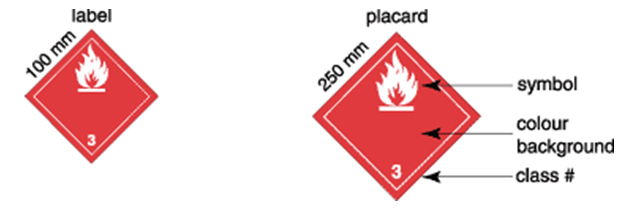
Figure 1: Label and placard (Image from Transport Canada)
What safety marks are required on a small means of containment (capacity 450L or less)?
Back to topDepending on the classification of the dangerous good, one or more of the following safety marks may be required on a small means of containment:
- Label for the primary hazard class for each dangerous good in the package
- Label for the subsidiary hazard class (if any) for each dangerous good in the package
- Shipping name and technical name when required in Special Provision 16 in Schedule 2 of the TDG Regulations
- Identification number—The UN Number must be displayed within a white rectangle on the primary class label itself or next to the primary class. When tags are used, the UN number must be displayed on the primary class label or on the tag next to the primary class label. The letters “UN” must not be included with the number when the UN number is displayed on the primary class label.
- “Inhalation Hazard” words for Class 6.1 and Class 2.3 dangerous goods as applicable, or as required in a special provision 105.
- Category B Mark instead of the Division 6.2 label for UN3373 dangerous goods
- Package compliance certification marks (if required)
See Figure 2 for an example of safety marks on a small means of containment such as a package.
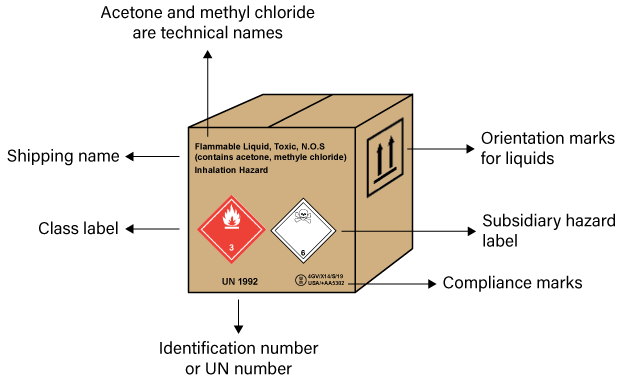
Note 1: The orientation marks for liquids are optional for road transport, but mandatory for air transport.
Note 2: Package compliance marks are specified in the standard that the package or container is compliant with. This requirement is outlined in Part 5 of the TDG Regulations.
Note 3: The containers inside the package are not required to bear TDG dangerous goods marks or dangerous goods safety marks.
Note 4: As the dangerous good is not identified with UN3373, the Category B mark is not required for the above package.
Are there other requirements for labels on a small means of containment?
Back to topYes. The labels must be displayed on any side of the outer surface of a means of containment other than the side on which it is intended to rest or be stacked during transport. For a cylinder containing dangerous goods, the label must be displayed on or near the shoulder of the cylinder as shown below [Subsection 4.10(3)(b)].
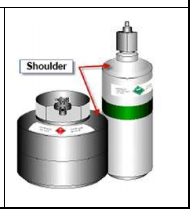
Figure 3: Labels on cylinders. Image from Alberta EDGE (Environmental and Dangerous Goods Emergencies), Alberta Transportation
If a small means of containment is placed inside another, and the outer container is not opened during loading, transport or unloading, the label is required only on the outer small means of containment.
Generally, if the shipment includes dangerous goods in Class 7, Radioactive Materials, then two labels are required on the small means of containment. The labels must be displayed on two opposite sides of the outer surface of a small means of containment. See Section 4.10(5) in the TDG Regulations for circumstances when labels are not required and the "Packaging and Transport of Nuclear Substances Regulations" for specific marking requirements.
What safety marks are required on a large means of containment (capacity 450L or more)?
Back to topDepending on the classification for a dangerous good, one or more of the following dangerous goods marks or dangerous goods safety marks may be required on a large means of containment:
- Placard for the primary hazard class must be displayed on each side and each end (total of four) for each dangerous good
- Placard for the subsidiary hazard class (if any) must be displayed next to the primary hazard class placard on each side and each end (total of four) for:
- Each dangerous good that must have an ERAP, and
- Has a subsidiary classification of Class 1 (1.1,1.2, 1.3 above the exemption limits), Class 4.3, Class 6.1 (Packing Group I), Class 8 (applies only to UN numbers N2977 and UN2978).
- Identification number - UN Number must be displayed either within the center of the placard in the white rectangle or on an orange panel safety mark (see the table for “other" safety marks) without the letters “UN” next to the placard when required in Sections 4.15.2 of Part 4 in the TDG Regulation. Except for Class 1, Explosives; UN numbers are only required for:
- those dangerous goods that must have an ERAP, or
- those dangerous goods that are liquid or gas in direct contact with the large means of containment
- “Inhalation Hazard” words on two opposite sides of the containment for dangerous goods:
- as listed in Special provision 23 and as required in Special provision 105 of Schedule 2 of the TDG Regulations,
- classified in Class 6.1, Toxic substances because the dangerous good meets the inhalation toxicity criteria and Class 2.3, Toxic Gases
- Elevated temperature sign (if applicable)
- Fumigation sign (if applicable)
- Container compliance marks as required by the standard cited in the TDG Regulations that the container is compliant with
NOTE: Generally speaking, a placard must be displayed for each of the dangerous goods transported in a large means of containment regardless of the quantity inside the container. Also, regardless of the quantity of dangerous goods on board, the primary class placard for each of the dangerous goods in a large means of containment must be displayed on each side and on each end of the “large means of containment” or “means of transport”. If two or more dangerous goods have different UN numbers but are identified by the same placard or placards, the placard is required to be displayed only once on each side and on each end of a large means of containment regardless of how many products in the large means of containment have that class (primary or subsidiary) [See Section 4.15 in the TDG Regulations].
See the images below for examples of how to place the dangerous goods placards on large means of containments such as a highway tank (Figure 3), and compartmentalized means of containment (Figure 4).

Figure 3: Placard requirement and placement for a single dangerous good transported in a highway tank Image from Transport Canada.

Figure 4: Placard requirements and placement for compartmentalized means of containment.
Image from Transport Canada.
How many placards are required on a large means of containment?
Back to topThe number of placards depends on the type of large means of containment, classification of the dangerous good, and the type of dangerous goods mark or dangerous goods safety mark that is required.
Generally, a large means of containment must have four placards (one on each side, one on the front and one in the back). However, the dangerous goods mark or dangerous goods safety mark requirements for large means of containment with a capacity of greater than 450 L but less than or equal to 3000 L (i.e., an intermediate bulk container) are:
- a placard and UN number may be displayed on two opposite sides of the intermediate bulk container, or
- a label for each primary and subsidiary class as well as a UN number and a shipping name, may be displayed on two opposite sides of the intermediate bulk container
Are safety marks required on overpacks?
Back to topPlacards are not required for overpacks as the definition and description for an “overpack” does not include “large means of containment”.
The labelling requirements for an overpack depend on whether the labels can be seen through the overpack. The required markings for overpacks include:
- when all of the dangerous good marks or dangerous goods safety marks can be seen through the overpack for each class of dangerous goods that is inside it, no additional labels or other dangerous goods marks or dangerous goods safety marks are required.
- When the dangerous goods marks or dangerous goods safety marks are not visible through the overpack, the requirements depend on the size of the overpack. They are as follows:
- Overpacks with capacity less than 1.8 m3 (64 cubic feet) must display:
- The word “Overpack” that conforms to the TDG Regulations.
- On one side of the overpack, the primary class label and each subsidiary class label that are not the same for each dangerous good inside the overpack,
- On one side of the overpack, the shipping name and UN number for each dangerous good inside the overpack,
- Overpacks with capacity greater than or equal to 1.8 m3 (64 cubic feet) must display:
- The word “Overpack” that conforms to the TDG Regulations.
- On two opposite sides of the overpack, the primary class label and each subsidiary class label that are not the same for each dangerous good inside the overpack,
- On two opposite sides of the overpack, the shipping name and UN number for each dangerous good inside the overpack.
- Overpacks with capacity less than 1.8 m3 (64 cubic feet) must display:
Are safety marks required on consolidation bins?
Back to topPlacards are not required for consolidation bins as the definition and description of a “consolidation bin” do not include “large means of containment.”
When a consolidation bin is used, the class of each dangerous good contained in the bin must be marked on a tag or on a fixed display device attached to the bin. The device can be either a tag or a fixed display device (e.g., a whiteboard or a piece of paper) that will be updated every time a dangerous good is removed or added (Section 4.10.2 in the TDG Regulations).
Are there any exemptions for placards? And how does one select a placard for different loads?
Back to topPlacards are not required or are optional for some dangerous goods when the gross quantity of the dangerous goods is 500 kg or less. See Table 1 below for placard requirements.
NOTE: The table below is for guidance purposes only. Other requirements may be listed in other sections, regulations, Codes, or Acts that are not listed in this table. For more details, consult the legislation directly. Always consult the legislation that applies in your situation.
TABLE 1: Placard requirements
| ROAD SHIPMENT OF: | Placard requirement for ROAD SHIPMENT |
| Dangerous good: gross mass is 500 kg or less | Class placards are required when the dangerous goods are:
|
| Dangerous good: gross mass is 500 kg or less | Class placards are not required or are optional only for dangerous goods (one or more) with the following classifications that are present in the shipment:
Examples are available from the TDG Directorate’s FAQ in Part 4 under the question, “Can you explain the current placarding requirements?” |
| Mixed Loads: dangerous good whose gross mass is 1000 kg or less, and there are at least two different dangerous goods and the dangerous goods are contained in at least two small means of containment inside a large means of containment | Danger placards (instead of the individual class placards) may be displayed only for dangerous goods with the following classifications that are present in the shipment: :
|
Class 2 gases shipment in combination of two or more cylinders that have a combined capacity exceeding 450 L such that:
| The combination of cylinders may be placarded as one large means of containment. |
| Gross quantity of Class 1.4 (except Class 1.4S) is 1000 kg or less | Placards are not required |
| Any amount of Class 1.4S by road | Placards are not required |
| Class 1.1, 1.2, 1.3 or 1.5 explosives that are not subject to Special provision 85 or 86 in Schedule 2 of the TDG Regulations and the quantity is less than or equal to 10 kg | Placards are not required |
| Class 1.1, 1.2, 1.3 or 1.5 explosives that are subject to Special provision 85 or 86 in Schedule 2 of the TDG Regulations and the quantity is less than or equal to 1000 articles | Placards are not required |
What types of "other" safety marks may be required?
Back to topTable 2 below summarizes "Other" safety marks that may be required for a shipment of dangerous goods.
Table 2: Other safety marks have
| Safety Mark | When required |
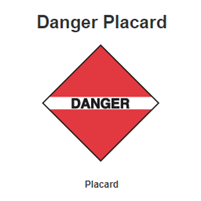 | Mixed loads 1000 kg or less This placard is not mandatory, but it is permitted on a large means of containment (greater than 450 L) instead of any other placard when the means of containment has:
NOTE: The TDG Regulations have specified circumstances when this placard is not allowed to be used. See Section 4.16(2) of Part 4 in the TDG Regulations. |
| Inhalation Hazard | These words "inhalation hazard" must be displayed on a small or large means of containment for dangerous goods with the following classifications and special provision requirements: :
Small means of containment: These words must be displayed next to the shipping name. Large means of containment: These words must be displayed on two opposite sides of the large means of containment in addition to any other safety marks that are required under the TDG Regulations. NOTE: The size of the “Inhalation hazard” letters varies for different types of means of containment. See Section 4.23 of Part 4 in the TDG Regulations |
Expected Quantities Mark 
| This mark is required when shipments meet the excepted quantity exemption. This mark must be displayed on one side of a means of containment that is visible when stacked. See Section 1.17.1 in the TDG Regulations. Dangerous goods that can be shipped under this exemption will have an excepted quantity code of E1, E2, E3, E4, or E5 in Column 6(b) of Schedule 1 of the TDG Regulations. |
Limited Quantity Mark 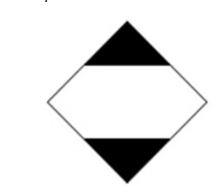 | This mark is required when shipments meet the limited quantity exemption and must be displayed on one side of a means of containment that is visible when stacked. See Section 1.17 in the TDG Regulations. Dangerous goods that can be shipped under this exemption will have a limited quantity index greater than 0 in Column 6(a) of Schedule 1 of the TDG Regulations. |
Elevated Temperature Sign 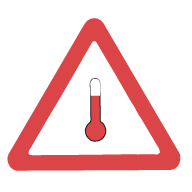
| Dangerous goods in large means of containment (greater than 450 L) that are transported at:
This sign must be displayed on each side and on each end of the large means of containment (i.e., a total of 4 signs) next to each primary class placard for the dangerous goods or, if there is a subsidiary class placard, next to the subsidiary class placard. |
Fumigation Sign  | This sign must be displayed at or next to each entryway of the large means of containment (greater than 450 L) when the containment is fumigated with a dangerous good but not yet ventilated and the cargo that was fumigated has not been unloaded. |
Marine pollutant mark 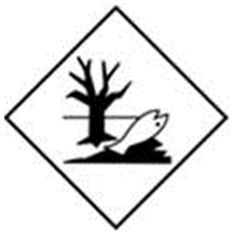
| Not required to be displayed on road vehicles. Only required when a marine pollutant is being transported in a means of containment on a vessel. |
Category B mark 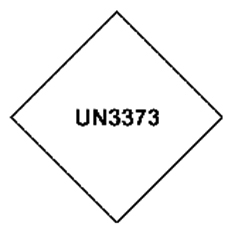
| This mark is displayed on small means of containment filled with infectious substances assigned to “UN3373, Biological Substance Category B”. NOTE: This category B mark must be displayed instead of the Class 6.2 label. |
Lithium battery mark 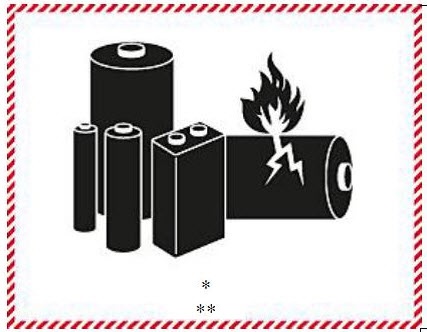
| The Class 9, lithium battery label, must be displayed on a small means of containment for the following dangerous goods:
When a shipment consists of batteries with different UN numbers, all applicable UN numbers must be indicated on one lithium battery mark or the UN numbers can be included on separate lithium battery marks. See Special Provision 34 in Schedule 2 of the TDG Regulations. |
Orange Panel 
| This is used to display the UN number on a large means of containment (greater than 450 L) when the UN number is not included in the hazard class placard. Note: The letters “UN” are not displayed, and the black numerals must not be less than 65 mm high. See the example below.
|
Images from Transport Canada
- Fact sheet first published: 2022-02-28
- Fact sheet last revised: 2024-08-14

